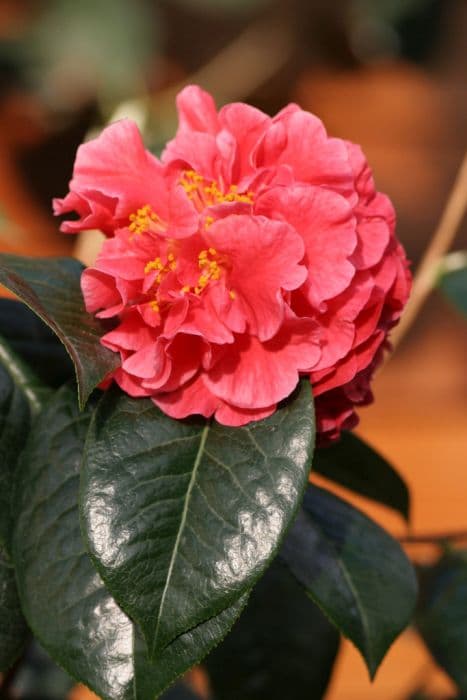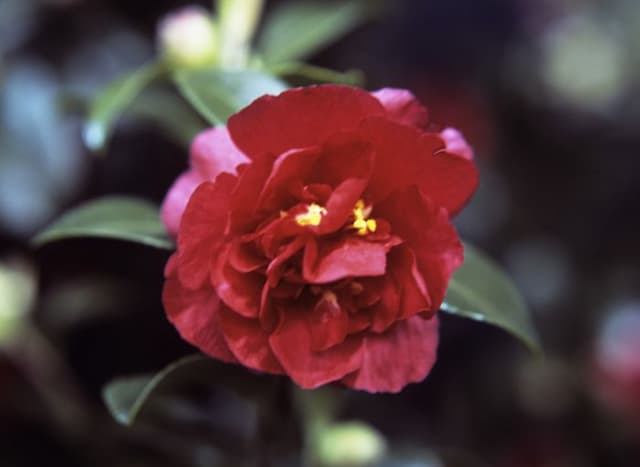Sasanqua Camellia Camellia sasanqua 'Plantation Pink'

ABOUT
The Plantation Pink camellia is a captivating shrub characterized by its glossy, dark green leaves that provide a lush backdrop for its distinctive flowers. The blooms, which appear typically in the fall and winter, are delicate yet showy, ranging in color from soft to vibrant pinks. Each petal is subtly ruffled, contributing to their overall elegance. The Plantation Pink flowers tend to have a classic, single form, meaning that they usually feature a relatively simple arrangement of petals around a central cluster of contrasting yellow stamens, creating an eye-catching focal point. The blossoms emanate a light, pleasant fragrance that can be a delightful addition to any garden. This plant often attracts pollinators such as bees and butterflies, adding to its charm. The overall impression that the Plantation Pink camellia leaves is one of grace and beauty, making it a favored choice for ornamental garden displays.
About this plant
 Names
NamesFamily
Theaceae
Synonyms
Sasanqua Camellia, Christmas Camellia, Yuletide Camellia
Common names
Camellia sasanqua 'Plantation Pink'.
 Toxicity
ToxicityTo humans
The Sasanqua camellia is not considered toxic to humans. It does not typically cause poisoning or adverse reactions if ingested. However, as with any plant, individual sensitivities can vary and it's generally advisable not to consume plant parts that are not known to be edible.
To pets
The Sasanqua camellia is also not considered toxic to pets. It should not cause any symptoms of poisoning in animals if they ingest parts of the plant. Nevertheless, it is always best to prevent pets from eating plants as some individuals may have sensitivities or can have an upset stomach from eating non-food items.
 Characteristics
CharacteristicsLife cycle
Perennials
Foliage type
Evergreen
Color of leaves
Green
Flower color
Pink
Height
4-8 feet (1.2-2.4 meters)
Spread
5-10 feet (1.5-3 meters)
Plant type
Shrub
Hardiness zones
7-9
Native area
Japan
Benefits
 General Benefits
General Benefits- Ornamental Value: Camellia sasanqua 'Plantation Pink' adds aesthetic appeal to gardens with its attractive pink blooms and evergreen foliage.
- Long Blooming Season: It typically flowers from fall to winter, offering color in the garden when many other plants are dormant.
- Low Maintenance: This plant is known to be relatively easy to care for, requiring minimal pruning and being tolerant of some drought once established.
- Versatility: It can be used in various landscape applications, including hedges, screens, or as a specimen plant due to its growth habit and size.
- Shade Tolerance: It can thrive in partial shade, making it suitable for growing under the canopy of larger trees or in less sunny areas of the garden.
- Cold Tolerance: It is relatively cold-hardy, making it suitable for cultivation in many temperate regions.
- Tolerant to Pests and Disease: Camellia sasanqua generally has good resistance to pests and diseases, reducing the need for chemical treatments.
- Wildlife Attraction: The flowers can attract pollinators like bees when they are in bloom, supporting local ecosystems.
 Medical Properties
Medical PropertiesThis plant is not used for medical purposes.
 Air-purifying Qualities
Air-purifying QualitiesThis plant is not specifically known for air purifying qualities.
 Other Uses
Other Uses- The petals of sasanqua can be used to add a colorful accent to salads or desserts, offering a mild taste and decorative flair.
- Sasanqua seed oil, extracted from the seeds of the plant, is sometimes used in hair care products for its moisturizing properties.
- Dried sasanqua petals can be incorporated into potpourri blends for a subtle fragrance and aesthetic value.
- Floral artists sometimes utilize sasanqua blooms in pressed flower crafts due to their delicate beauty and variety of colors.
- Sasanqua plants can be shaped into bonsai, offering a challenging yet rewarding experience for enthusiasts of this art form.
- The flowers can be used in making natural dyes for fabrics, providing a range of soft colors based on the blossom shades.
- Cooked sasanqua petals are sometimes used in gourmet jellies or syrups, offering a unique floral note to dishes.
- Leaves of the sasanqua plant can be brewed to make a light tea, although not as commonly as the leaves of its cousin, the tea plant Camellia sinensis.
- Sasanqua wood, being sturdy and attractive, might be used in small woodworking projects such as crafting handles or decorative inlays.
- When in bloom, sasanqua plants can serve as a natural magnet for pollinators like bees and butterflies, enhancing biodiversity in a garden.
Interesting Facts
 Feng Shui
Feng ShuiThe sasanqua camellia is not used in Feng Shui practice.
 Zodiac Sign Compitability
Zodiac Sign CompitabilityThe sasanqua camellia is not used in astrology practice.
 Plant Symbolism
Plant Symbolism- Admiration: Camellia sasanqua, commonly known as Sasanqua camellia, is often symbolizing deep admiration for someone's beauty and talent.
- Love: Giving a Sasanqua camellia can convey a message of love, as camellias in many cultures are associated with the feelings of passion and romantic desire.
- Perfection: The camellia's perfectly formed petals are often seen as a symbol of perfection. It can represent the idealized form of beauty or excellence.
- Longevity: Since Sasanqua camellias are evergreen and have a long blooming season, they are often associated with the idea of a long and prosperous life.
- Gratitude: Camellia flowers, due to their beauty and long-lasting nature, can also symbolize gratitude when gifted to someone as a token of appreciation.
 Water
WaterSasanqua camellias, like 'Plantation Pink', should be watered deeply and thoroughly to maintain moist but not waterlogged soil, particularly during dry spells. Depending on the climate and weather conditions, watering might be necessary once or twice a week. Generally, aim to provide about 1 to 1.5 gallons of water per week during the growing season, reducing frequency in cooler months. Always check the top few inches of soil for dryness before watering. Overwatering or poor drainage can lead to root rot, so ensure good soil drainage.
 Light
LightSasanqua camellias, including the 'Plantation Pink' variety, thrive in partial shade with some morning sun and afternoon shade. They can tolerate full sun in cooler climates but prefer protection from the intense midday sun. The best spot for these plants is one where they receive filtered light or are shaded by taller trees that provide a dappled sunlight effect.
 Temperature
TemperatureSasanqua camellias, such as 'Plantation Pink', prefer moderate temperatures and can generally tolerate conditions between 20 to 90 degrees Fahrenheit. They do best in a temperature range of 60 to 70 degrees but can survive short periods of colder weather down to 20 degrees. Protection from extreme cold and hot temperatures helps maintain plant health and flower quality.
 Pruning
PruningPrune 'Plantation Pink' sasanqua camellias immediately after blooming to maintain plant shape and encourage bushier growth. Light pruning every year or more substantial pruning every two to three years can be appropriate, depending on the plant's growth and desired size. The best time for pruning is late winter or early spring, just before new growth begins.
 Cleaning
CleaningAs needed
 Soil
SoilSasanqua Camellia prefers acidic soil with a pH range of 5.5 to 6.5. The best soil mix is well-draining and rich in organic matter; a combination of 1/3 pine bark, 1/3 garden soil, and 1/3 peat moss is ideal. Ensure the planting mix is kept consistently moist but not waterlogged.
 Repotting
RepottingSasanqua Camellias should be repotted every 2-3 years. Choose a slightly larger pot each time to accommodate root growth. The best time for repotting is in late winter or early spring before the growing season starts.
 Humidity & Misting
Humidity & MistingSasanqua Camellias thrive in moderate to high humidity levels, ideally between 50% and 60%. These humidity conditions support their growth and flower development without extra watering measures specifically for humidity control.
 Suitable locations
Suitable locationsIndoor
Use acidic soil, indirect light, and keep above 50% humidity.
Outdoor
Full to partial sun, well-drained acidic soil, protect from cold winds.
Hardiness zone
7-9 USDA
 Life cycle
Life cycleThe life of a 'Plantation Pink' sasanqua camellia begins as a seed, which, when planted and germinated, becomes a seedling. The seedling grows into a juvenile plant, focusing on developing its root system and foliage. As it matures, the sasanqua camellia enters the vegetative stage, where it grows larger and starts to form its characteristic evergreen leaves. Once it has reached maturity, typically after a few years, it enters the flowering stage, producing delicate pink blossoms usually in the fall or early winter. After pollination, the flowers develop into seed pods, completing the reproductive cycle. The plant then continues to grow and cycle through seasonal blooming each year, with proper care and favorable conditions allowing it to live and thrive for several decades.
 Propogation
PropogationPropogation time
Early Spring
Propogation: Camellia sasanqua 'Plantation Pink', commonly known as Sasanqua camellia, is typically propagated through semi-hardwood cuttings. The optimal time for taking cuttings is during the late summer or early fall, when the plant has finished its primary growth phase and the wood is not too tender or too hard. For this method, cuttings approximately 4 to 6 inches (10 to 15 cm) long are taken from the current year's growth. The lower leaves are removed, and the base of the cutting is dipped in a rooting hormone to encourage root development. Then, the cutting is planted in a well-draining soil mix, ensuring that the leaf nodes, where roots are most likely to develop, are covered. The soil should be kept moist, and the cuttings should be placed in a warm environment with indirect light. With proper care, roots typically develop within a few weeks to a few months, after which the new plants can be gradually acclimated to normal growing conditions and eventually transplanted outdoors.









